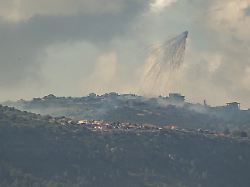Army bases as targets
Hezbollah fires more than 100 rockets at Israel
March 12, 2024, 11:53 a.m
On Monday evening, the Israeli military shelled several Hezbollah positions deep in Lebanon. The answer follows the next morning: the militia fires more than 100 rockets. There are no reports of deaths or injuries.
After Israeli air strikes on targets in northeast Lebanon, there was heavy fire from the neighboring country. Hezbollah in Lebanon said it had fired “more than 100” rockets at Israel. The militia said Air and Missile Defense Command bases and a missile base in the Israeli-occupied Golan Heights were attacked.
Israeli media had previously reported, citing the military, that around 100 projectiles had been fired towards the Israeli-occupied Golan Heights. There have been no reports of injuries or damage so far. Many projectiles were intercepted or landed in open areas. When asked, the army said it was checking the reports. The Israeli military said it had attacked three rocket launchers in Lebanon. These were used to fire rockets in the direction of the Golan Heights in the morning.
Almost daily attacks
Israel’s army said it attacked two Lebanese Hezbollah positions in the Bekaa Valley on Monday evening. It was only the second attack by Israel’s military on the area, located about 100 kilometers north of the country’s border, since the beginning of the Gaza war, the Israeli news site “Ynet” reported on Monday evening.
Lebanese security circles said there were also victims in the Israeli attacks. Israel’s military said the attacks on locations of the “Hezbollah Air Force” – probably referring to Hezbollah fighters who launch drones – in northeast Lebanon were in retaliation for air strikes by the militia.
Since the beginning of the Gaza war after the Hamas massacre in Israel on October 7th, mutual attacks have occurred almost daily between the Hamas-allied Hezbollah and Israel, concentrated in the border region. Israel wants to ensure that Hezbollah retreats behind the Litani River, 30 kilometers from the border – as stipulated in a UN resolution from 2006.
